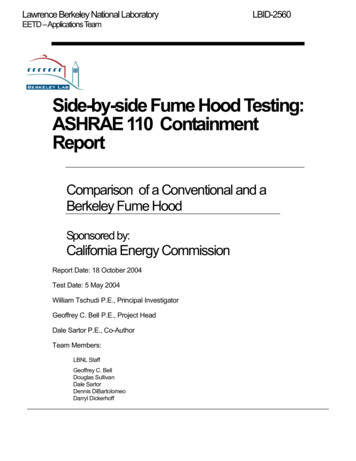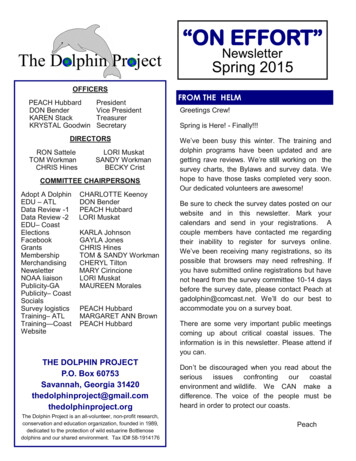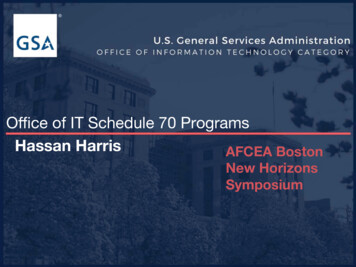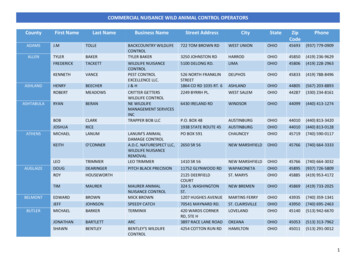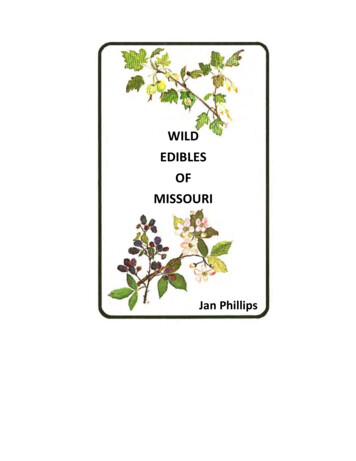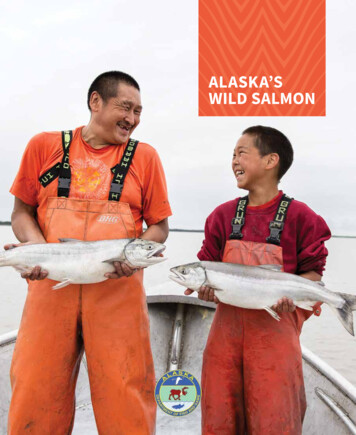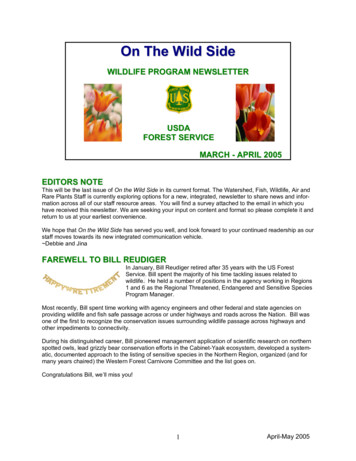
Transcription
On The Wild SideWILDLIFE PROGRAM NEWSLETTERUSDAFOREST SERVICEMARCH - APRIL 2005EDITORS NOTEThis will be the last issue of On the Wild Side in its current format. The Watershed, Fish, Wildlife, Air andRare Plants Staff is currently exploring options for a new, integrated, newsletter to share news and information across all of our staff resource areas. You will find a survey attached to the email in which youhave received this newsletter. We are seeking your input on content and format so please complete it andreturn to us at your earliest convenience.We hope that On the Wild Side has served you well, and look forward to your continued readership as ourstaff moves towards its new integrated communication vehicle. Debbie and JinaFAREWELL TO BILL REUDIGERIn January, Bill Reudiger retired after 35 years with the US ForestService. Bill spent the majority of his time tackling issues related towildlife. He held a number of positions in the agency working in Regions1 and 6 as the Regional Threatened, Endangered and Sensitive SpeciesProgram Manager.Most recently, Bill spent time working with agency engineers and other federal and state agencies onproviding wildlife and fish safe passage across or under highways and roads across the Nation. Bill wasone of the first to recognize the conservation issues surrounding wildlife passage across highways andother impediments to connectivity.During his distinguished career, Bill pioneered management application of scientific research on northernspotted owls, lead grizzly bear conservation efforts in the Cabinet-Yaak ecosystem, developed a systematic, documented approach to the listing of sensitive species in the Northern Region, organized (and formany years chaired) the Western Forest Carnivore Committee and the list goes on.Congratulations Bill, we’ll miss you!1April-May 2005
THE INTERMOUNTAIN REGION WELCOMES A NEW WILDILFEPROGRAM LEADERWe are pleased to announce that Danielle Chi has been offered and has accepted the R-4 Wildlife Program Manager position (vice Brian Ferebee). Danielle is currently working with the U. S. Fish & WildlifeService in California. Danielle has held several positions in both the public and private sector in theWestern US, and we are welcoming her back to Utah -- she received her Doctorate degree in Wildlife Biology from Utah State University. Danielle will officially be reporting to her new position about the thirdweek in May. Welcome Danielle!BLM DIRECTOR/USDA FOREST SERVICE CHIEF AWARDSRECEPTION AT THE 71ST NORTH AMERICAN CONFERENCEThe annual BLM Director / USDA Forest Service Chief Awards Reception were held March 16, 2005 during the 71st North American Wildlife and Natural Resource Conference at the Crystal Gateway Marriott inArlington, Virginia.TWO PROJECTS SELECTED FOR BLM/FS “CONSERVATION PROJECT” AWARDThe first awarded was given to the Western SnowyPlover Working Team. This team has been a model for asuccessful interagency working group that has madesignificant contributions to the conservation and recoveryof both the habitat and populations of Western SnowyPlover. The team has coordinated and implementedextensive habitat restoration efforts, with successmeasured in birds actually moving in and nesting in theimproved habitat. The team’s dedicated efforts over thepast ten years have directly influenced fledgling survival,and have ultimately resulted in an increase in thepopulation. Accepting on behalf of the project were KerriePalermo, of the BLM-Coos Bay District, and Carl Frounfelker of the Siuslaw National Forest, and CynthiaBurns, also of the Siuslaw National Forest.The second award was presented to the InteragencyConservation Strategy Team for the Grizzly Bear in theGreater Yellowstone Area. The Interagency ConservationStrategy Team of the Forest Service, BLM, U.S. Fish andWildlife Service, National Park Service, U.S. GeologicalSurvey, Idaho Fish and Game, Montana Fish, Wildlife, andParks, and Wyoming Game and Fish Department, overcamehigh profile controversy and culminated 10 years ofcollaborative effort with the completion of a comprehensiveConservation Strategy for grizzly bear management in theGreater Yellowstone Area. This conservation strategy,which incorporates State management plans for the State ofIdaho, Montana, and Wyoming, as well as guidance forFederal land management agencies, is a critical step towards delisting the Yellowstone population ofgrizzly bears. It ensures that adequate regulatory mechanisms will be in place to conserve grizzly bearsonce they are removed from the Federal endangered species list. Accepting on behalf of the project wasChuck Schwartz, Interagency Grizzly Bear Study Team Leader of the United States Geological Survey,Chris Servheen, Grizzly Bear Recovery Coordinator of the U.S. Fish and Wildlife Service, and Bob Summerfield, Grizzly Bear Habitat Coordinator for the Forest Service.2April-May 2005
ROCKY MOUTAIN ELK FOUNDATION HONORED WITH “CONSERVATIONPARTNER” AWARDThis year’s recipient of the Conservation Partner award was the Rocky Mountain Elk Foundation. Accepting on behalf of the Foundation was Jim Gladen, Vice President of Lands and Conservation.The Rocky Mountain Elk Foundation was founded in 1984and has been working under national partnership memorandums of understanding (MOUs) with the Forest Serviceand the Bureau of Land Management since 1987. Underthese MOUs, the partnership has included stewardship,conservation education, land acquisition, land easement,research, and elk restoration projects. This organizationwas started by people that strongly support multiple usesof our public lands. The Rocky Mountain Elk Foundationhas a membership base of 150,000 members and iswidely regarded as the organization to go to when youneed to get things done, anywhere in elk country. The Rocky Mountain Elk Foundation has helped fund atotal of 2,280 projects and contributed over 15, million dollars. These projects have protected or enhanced more than 3 million acres over the past 20 years.JACK CAPP RECIEVES LLOYD SWIFT SR. AWARDThe Lloyd Swift Senior award is presented to a current or pastForest Service employee in the field of wildlife, fisheries andrare plants, who exemplifies the characteristics, accomplishments, and qualities of Lloyd W. Swift Sr., a Wildlife Biologistand national director for the Forest Service (1928-1963).Awardees must have demonstrated a lifetime of dedication,commitment, and leadership in management of the wildlife andfisheries resources of the United States.During his exceptional career, Jack has been on the forefrontof many important projects and programs. In the InternationalForestry arena, Jack has led Forest Service participation inconservation of Siberian tiger habitat in Russia, Panda habitatin China, and the bush meat issue in Africa. He is also a former Director of wildlife in the Alaska Region.Jack is actively involved in the North American Bird Conservation Initiative which is the coordinating bodycomposed of Federal, State and NGO partners to conserve birds.GRANT GUNDERSON PRESENTED JACK ADAMS AWARDGrant Gunderson was presented with the Jack AdamsAward for his exemplary work during his career with theForest Service.The Jack Adams Award is presented annually to a ForestService wildlife biologist, fish biologist or botanist who,over their career, has exemplified the characteristics andqualities of Jack Adams, wildlife biologist for the ForestService (1961-1984). These characteristics include steadyhard work and dedication to balanced resource management of the national forests and ensuring that wildlife, fisheries and rare plants needs are fully reflected in all management decisions.3April-May 2005
Recently retired, Grant is a wildlife biologist who championed the integration of the best available sciencewhen applying the Northwest Forest Plan, and provided leadership, support and mentoring to Forest Service wildlife, range and grassland programs.2005 WINGS ACROSS THE AMERICAS BIRD CONSERVATIONAWARDSOn March 17, 2005, the USDA Forest Service and its partners celebrated thefirst annual Wings Across the Americas 2005 Bird Conservation Awards. Theceremony was hosted during the 70th Annual North American Wildlife andNatural Resources Conference in Arlington, Virginia. Partnerships were a keyattribute of selected recipients. Awards were given to those projects thatreflected a partnership between the USDA Forest Service and partners.Awards were given in the following categories: Research and Management,Habitat Conservation (2) and International Cooperation (2).Research and Management AwardThe Research and Management Award was presented to theKirtland’s Warbler Research and Training Program. Awardswere presented to the following USDA Forest Service employeesand units: Dr. Joe Wunderle, Kenneth Ennis, Phil Huber, the International Institute of Tropical Forestry and the Huron-ManisteeNational Forest. Partners awarded include the Puerto RicoConservation Foundation, the Bahamas National Trust and TheNature Conservancy.The Kirtland’s Warbler Research and Training Program is anoutstanding example of recovery of a species through thecollaboration of diverse partners across large landscapes andinternational boundaries. Professionals in Michigan are restoring the breeding habitats needed and controlling competing species while research scientists in The Bahamas are determining the Warbler’s locations and requirements during the 9 month non-breeding season.Habitat Conservation AwardThe Habitat Conservation Award was presented to The SouthernRegion Bird Conservation Strategy and Partnerships. Awards werepresented to the following USDA Forest Service employees: TomDarden, Dave Wilson, Ernesto Garcia, Tim Mersmann, Paul Hamel,John Kilgo, Gary Peters, Laurel Moore, Eddie Morris, Margaret Griep,Carol Hardy, Frank Thompson, Bill Lisowsky, Steve Rickerson and GlenGaines. Partners awarded include the Atlantic Coast Joint Venture,Lower Mississippi Valley Joint Venture, and Central Hardwood JointVenture.The Southern Region Bird Conservation Strategy and Partnershipsdeveloped and implemented an outstanding landbird conservationstrategy resulting in new partnerships and habitat improvement projectson the ground. This partnership has also established more than 5,000bird point count stations and bird watching sites. Information collected atthese stations has been used to create an effective database from whichthe Southern Region’s 16 national forests, national grasslands, andpartners are using information to design land management to sustain birds.4April-May 2005
The second Habitat Conservation Award went to the Ouachita Native Flora and Fauna Restorationproject. USDA Forest Service employee Larry Kendrick and the Ouachita National Forest were both presented with awards for their efforts. Partners awarded include Oklahoma State University, National WildTurkey Federation, Quail Unlimited, Arkansas Game and Fish Commission and Arkansas Audubon Society.Through an integrated ecosystem restoration approach and community outreach, the Ouachita NationalForest and its partners have advanced bird conservation. Through re-establishing early succession habitat and sustaining older forest conditions, 68 species of birds have benefited significantly.International Cooperation AwardThe Western Boreal Forest Initiative received theInternational Cooperation Award. USDA Forest Serviceemployees Dan Logan and Chris Iverson were presented withawards. Ducks Unlimited also received an award for their involvement with this special partnership.Through this Initiative, over 20 research projects have beenconducted, 100 million acres of forested wetlands have beeninventoried, 25 million acres of priority habitat are now protected,and over 20 million acres are now under sustainable useagreements with natural resource development corporations.The second International Cooperation Award went to the Conserving Grassland Bird Habitats In Mexico project. USDA Forest Serviceemployees awarded include Skip Kowalski, Dan Svingen, Tim Byerand John Sidle. Partners awarded included The Nature Conservancy,Pronatura Noreste, Mexico and the University of Chihuahua, Mexico.For this project, partners from Mexico, Canada and the US formed anew coalition. They are sharing data, plus land management expertiseand field techniques to inventory birds, prairie dog colonies, andimprove habitats in all three nations. The grassland birds of NorthAmerica are showing the greatest decline of any group of bird species on the Continent. There is a particular need for understanding migratory bird use and improving habitats in Mexico where these birdsspend the winter after breeding in the United States and Canada.ROCKY MOUTAIN ELK FOUNDATION PRESENTS 2004 ELKCOUNTRY AWARDSThe 2004 Elk Country Awards were held this past February in Portland, Oregon during the 21st Annual Elk CampConvention. Awards were presented in the following areas:Land Protection, Habitat Management, ConservationEducation and Individual Achievement.Land ProtectionThe Land Protection award was presented to the GreaterYellowstone – Taylor Fork – Taylor Fork – LandConservation project. Bob Dennee (Gallatin NationalForest, Lands), John Allen (Deputy Forest SupervisorGallatin NF), Ron Erickson (USFS Region 1, Lands) andKurt Alt (MT Fish, Wildlife and Parks) received awards.5April-May 2005
From 1993 to 2004, the Forest Service worked in partnership with the Rocky Mountain Elk Foundationand Montana Fish, Wildlife and Parks, and with local residents, conservation and sportsman groups, theMontana Congressional delegation, and the landowners to acquire and conserve over 11,000 acres ofprivate lands in the wildlife-rich Taylor Fork area of the Gallatin National Forest. The Taylor Fork projectrepresents another chapter in the long-term partnership between the FS, RMEF, FWP and the NationalPark Service to conserve critical elk habitat north of Yellowstone National Park.Habitat ManagementThe Tusayan and Williams Ranger Districts, Kaibab National Forest was presented with the HabitatManagement award. Recipients included Paul Webber (Kaibab NF) and Steve Best (District RangerKaibab NF). From 1995 to the present, Paul Webber, a Forest Service Range Specialist, has worked inpartnership with the Rocky Mountain Elk Foundation and others to enhance habitat for elk and other species on the Tusayan and Williams Ranger Districts of the Kaibab National Forest in northern Arizona.During this time, Paul has been involved in reconstructing 14 water sources in elk habitat and in restoringover 20,000 acres of grassland habitat.Conservation EducationThe Conservation Education award was presented to the Protecting Elk Winter Range EducationalProgram. Dale Dawson (Bridger-Teton NF) and Kniffy Hamilton (Supervisor Bridger-Teton National Forest) accepted the awards. In 1990 the Bridger-Teton National Forest approved a winter travel plan whichclosed areas of crucial winter wildlife habitat to all human presence between December 1st and May 1st.On the Jackson Ranger District, approximately 112,000 acres are closed to all human presence (16% ofthe district). With rapid growth in backcountry skiing, snowmobiling, and walking on packed trails, violations of the wildlife winter range closures were becoming increasingly common. Concern about increasing violations led federal and state agencies to partner with local non-profit conservation organizations todevelop a public education campaign to raise awareness about the need to respect wildlife winter rangeclosures entitled “Don’t Poach the Powder”.Individual AchievementUSDA Forest Service employee Michael D. Feiger of the Pacific Northwest Region, Oregon, Malheurand Ochoco National Forests received the individual achievement award in recognition of his long termsuccess in rallying volunteers for elk habitat restoration work in Region 6. Mike’s dedication and commitment to wildlife restoration has made his projects among the most successful volunteer based projects inRegion 6. Mike has a knack for stretching conservation dollars through the wise use of volunteers. He isseen as an expert in the development of Challenge Cost Share Partnerships. Folks in the Forest Serviceand RMEF know that when they see a proposal from Mike, it will be well planned, cost effective, andimplemented in a timely fashion.NATIONAL WILD TURKEY FEDERATION’S MAKING TRACKS AWARDThe National Making Tracks Awards were presented duringthe NWTF’s 29th Annual Convention and Sport Show inNashville, Tennessee this past February. The NationalMaking Tracks awards recognize outstanding USFS andBLM employees for their accomplishments that bestincorporate conservation education, partnerships and activewild turkey management into ecosystem managementprojects across our national forests and grasslands.Robert Abernethy, NWTF’s Director of Agency Programs,and Anne Zimmerman, USDA Forest Service’s Acting Director of Wildlife, Fisheries and Watershed, presented the6April-May 2005
awards to the following individuals: Habitat Management Projects - Terri Malone and Steve McClendon, Ozark- St. Francis National Forests Habitat Management Programs - The Grandfather Ranger District, NationalForests in North Carolina and these North Carolina NWTF chapters: TheFirst Light Chapter, The Foothills Chapter, The Wingbone Chapter, TheAppalachian Gobblers Chapter and the Linville Chapter Habitat Management Programs - Mark Twain National Forest Conservation Education - Liz Caldwell, Chattahoochee –Oconee National Forest Partnership Achievement - Jerry Wood, Chattahoochee –Oconee National ForestMULE DEER CONSERVATION AWARD PRESENTED TO THE LINCOLNNATIONAL FORESTAt the Fifth Annual Mule Deer Foundation Conventionand Exposition the Lincoln National Forest of Alamogordo, New Mexico, was presented with the MuleDeer Conservation Award for their project entitled“Lincoln National Forest Habitat Stamp Program for MuleDeer.” The convention was held January 14-16, 2005 inReno, Nevada.The Lincoln National Forest has contributed 1.7 milliondollars to mule deer projects in Southeastern NewMexico since the start of the Habitat Stamp Program in1988. In fact, the Lincoln was one of two pilot forests forthis program in the State of New Mexico. Due to thesuccesses during the initial years of the program on the Lincoln, the Habitat Stamp Program went statewide in 1990.One common, consistent thread through the past 16 years has been the Habitat Stamp Coordinator forthe Lincoln National Forest, Mr. Danny Waldon. Danny has dedicated himself to ensuring that the HabitatStamp Program remains a model and example for Mule Deer habitat projects in the state of New Mexico.Danny works hard to ensure that every partnership dollar is spent for on-the-ground project implementation. In addition, he also contributes his own personal time and money to support our partners by attending banquets for the Mule Deer Foundation, Rocky Mountain Elk Foundation and the National Wild Turkey Federation.FOREST SERVICE SIGNS NEW MOU WITH THE ROCKY MOUTAINELK FOUNDATIONOn March 17, 2005, in conjunction with the North American Wildlife and Natural Resources Conference, the Forest Service andRocky Mountain Elk Foundation (RMEF) renewed their commitment to working together during the signing of a newMemorandum of Understanding (MOU). Together, through anoutstanding partnership and the tireless efforts of chapter volunteers, the Forest Service and RMEF have partnered on over1,700 projects, resulting in the conservation of over 2 millionacres of elk country. The Forest Service manages over 80million acres of elk habitat on 83 national forests and 6 nationalgrasslands—with approximately 800,000 elk spending all or a7April-May 2005
portion of their lives on National Forest System lands. The new MOU renews a national commitment topartnership--first signified by the original MOU between the Forest Service and RMEF, signed in 1987.Together, through efforts like the Measure and Pri
Service. Bill spent the majority of his time tackling issues related to wildlife. He held a number of positions in the agency working in Regions 1 and 6 as the Regional Threatened, Endangered and Sensitive Species Program Manager. Most recently, Bill spent time working with
